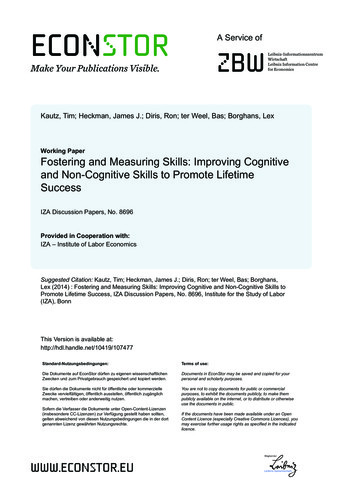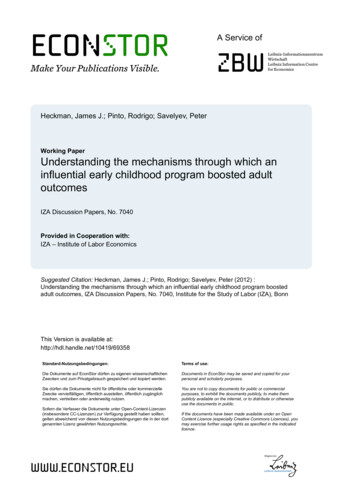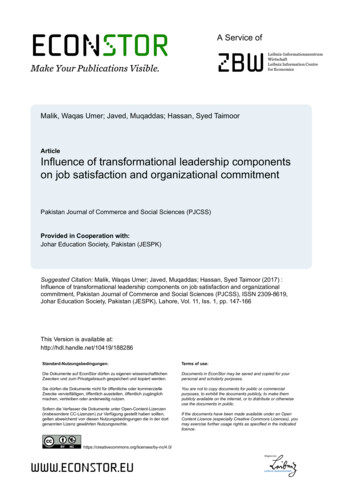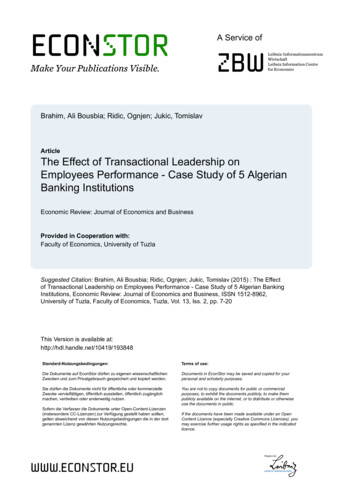
Transcription
econstorA Service ofzbwMake Your Publications iz Information Centrefor EconomicsKautz, Tim; Heckman, James J.; Diris, Ron; ter Weel, Bas; Borghans, LexWorking PaperFostering and Measuring Skills: Improving Cognitiveand Non-Cognitive Skills to Promote LifetimeSuccessIZA Discussion Papers, No. 8696Provided in Cooperation with:IZA – Institute of Labor EconomicsSuggested Citation: Kautz, Tim; Heckman, James J.; Diris, Ron; ter Weel, Bas; Borghans,Lex (2014) : Fostering and Measuring Skills: Improving Cognitive and Non-Cognitive Skills toPromote Lifetime Success, IZA Discussion Papers, No. 8696, Institute for the Study of Labor(IZA), BonnThis Version is available ungsbedingungen:Terms of use:Die Dokumente auf EconStor dürfen zu eigenen wissenschaftlichenZwecken und zum Privatgebrauch gespeichert und kopiert werden.Documents in EconStor may be saved and copied for yourpersonal and scholarly purposes.Sie dürfen die Dokumente nicht für öffentliche oder kommerzielleZwecke vervielfältigen, öffentlich ausstellen, öffentlich zugänglichmachen, vertreiben oder anderweitig nutzen.You are not to copy documents for public or commercialpurposes, to exhibit the documents publicly, to make thempublicly available on the internet, or to distribute or otherwiseuse the documents in public.Sofern die Verfasser die Dokumente unter Open-Content-Lizenzen(insbesondere CC-Lizenzen) zur Verfügung gestellt haben sollten,gelten abweichend von diesen Nutzungsbedingungen die in der dortgenannten Lizenz gewährten Nutzungsrechte.www.econstor.euIf the documents have been made available under an OpenContent Licence (especially Creative Commons Licences), youmay exercise further usage rights as specified in the indicatedlicence.
SERIESPAPERDISCUSSIONIZA DP No. 8696Fostering and Measuring Skills: Improving Cognitiveand Non-Cognitive Skills to Promote Lifetime SuccessTim KautzJames J. HeckmanRon DirisBas ter WeelLex BorghansDecember 2014Forschungsinstitutzur Zukunft der ArbeitInstitute for the Studyof Labor
Fostering and Measuring Skills:Improving Cognitive and Non-CognitiveSkills to Promote Lifetime SuccessTim KautzBas ter WeelUniversity of ChicagoCPB, Maastricht Universityand IZAJames J. HeckmanLex BorghansUniversity of Chicago,American Bar Foundation,IFS, University College London and IZAROA, Maastricht Universityand IZARon DirisKU LeuvenDiscussion Paper No. 8696December 2014IZAP.O. Box 724053072 BonnGermanyPhone: 49-228-3894-0Fax: 49-228-3894-180E-mail: iza@iza.orgAny opinions expressed here are those of the author(s) and not those of IZA. Research published inthis series may include views on policy, but the institute itself takes no institutional policy positions.The IZA research network is committed to the IZA Guiding Principles of Research Integrity.The Institute for the Study of Labor (IZA) in Bonn is a local and virtual international research centerand a place of communication between science, politics and business. IZA is an independent nonprofitorganization supported by Deutsche Post Foundation. The center is associated with the University ofBonn and offers a stimulating research environment through its international network, workshops andconferences, data service, project support, research visits and doctoral program. IZA engages in (i)original and internationally competitive research in all fields of labor economics, (ii) development ofpolicy concepts, and (iii) dissemination of research results and concepts to the interested public.IZA Discussion Papers often represent preliminary work and are circulated to encourage discussion.Citation of such a paper should account for its provisional character. A revised version may beavailable directly from the author.
IZA Discussion Paper No. 8696December 2014ABSTRACTFostering and Measuring Skills: Improving Cognitive andNon-Cognitive Skills to Promote Lifetime Success *This paper reviews the recent literature on measuring and boosting cognitive and noncognitive skills. The literature establishes that achievement tests do not adequately capturecharacter skills: personality traits, goals, motivations, and preferences that are valued in thelabor market, in school, and in many other domains. Their predictive power rivals that ofcognitive skills. Reliable measures of character have been developed. All measures ofcharacter and cognition are measures of performance on some task. In order to reliablyestimate skills from tasks, it is necessary to standardize for incentives, effort, and other skillswhen measuring any particular skill. Character is a skill, not a trait. At any age, characterskills are stable across different tasks, but skills can change over the life cycle. Character isshaped by families, schools, and social environments. Skill development is a dynamicprocess, in which the early years lay the foundation for successful investment in later years.High-quality early childhood and elementary school programs improve character skills in alasting and cost-effective way. Many of them beneficially affect later-life outcomes withoutimproving cognition. There are fewer long-term evaluations of adolescent interventions, butworkplace-based programs that teach character skills are promising. The common feature ofsuccessful interventions across all stages of the life cycle through adulthood is that theypromote attachment and provide a secure base for exploration and learning for the child.Successful interventions emulate the mentoring environments offered by successful families.JEL Classification:Keywords:D01, I20, J24non-cognitive skills, human development, interventionsCorresponding author:James J. HeckmanDepartment of EconomicsUniversity of Chicago1126 E. 59th StreetChicago IL 60637USAE-mail: jjh@uchicago.edu*This paper draws on Heckman and Kautz (2014a) and Heckman and Kautz (2014b). This report wascommissioned by the OECD through its project on Education and Social Progress. We thank LinorKiknadze and Edward Sung for valuable research assistance. We received helpful comments fromRichard Boyle, Zidi Chen, Maryclare Griffin, Robert Lerman, Seong Hyeok Moon, Dan Moran, MariaRosales, and Indra Wechsberg.
Executive SummaryThis paper reviews the recent literature on measuring and fostering cognitive andnon-cognitive skills. IQ tests and achievement tests do not adequately capture noncognitive skills—personality traits, goals, character, motivations, and preferences thatare valued in the labor market, in school, and in many other domains. For manyoutcomes, their predictive power rivals or exceeds that of cognitive skills.Evidence from the General Educational Development (GED) testing program in theUnited States shows the importance of non-cognitive skills. The GED is an achievementtest which dropouts can take to certify that they are equivalent to secondary schoolgraduates. The program is based on the widely held belief that tests capture theimportant skills learned in school. On the surface, the program is successful. Basedon test scores, GED recipients are just as smart as high school graduates. When itcomes to outcomes that matter, such as college completion and labor market success,GED recipients perform much worse in the labor market and in a variety of otherlife domains than traditional secondary school graduates. Achievement tests like theGED do not adequately capture valuable non-cognitive skills. This evidence shouldcause policymakers to think twice about relying on achievement tests to evaluate theeffectiveness of educational systems.Reliable measures of non-cognitive skills are available, and they are discussed in thispaper. In developing any measure of non-cognitive skills, it is essential to recognize thatall measures of skill are based on performance on some task. Traditional personalitytests are based on the performance of the task of self-description. Performance onany task depends on multiple skills as well as the effort expended on it. Effort, inturn, depends on the incentives offered to exert the effort to perform the task. Sinceall measures of cognitive and non-cognitive skill are measures of performance on sometask, it is necessary to standardize for incentives, effort, and other skills that determineperformance on the task in measuring any skill, yet this is rarely done in conductingskill assessments. Standard measures of cognitive skill have been shown to be sensitiveto incentives and levels of other skills. Test scores for young children can be improved2
by one standard deviation by offering candy for correct answers. The responsivenessto incentives in turn depends on a child’s levels of conscientiousness. Using measuredbehaviors to capture non-cognitive skill is a promising approach that has been shownto be empirically effective. Such measures are available in administrative data that arecollected routinely by schools and government agencies.Skills are stable across situations with different incentives, although manifestationsof skills vary with incentives. Though stable at any age, skills are not immutabletraits that are set in stone over the life cycle. They have a genetic basis but are alsoshaped by environments, including families, schools, and peers. Skill development isa dynamic process. The early years are important in shaping all skills and in layingthe foundations for successful investment and intervention in the later years. Duringthe early years, both cognitive and noncognitive skills are highly malleable. Duringthe adolescent years, non-cognitive skills are more malleable than cognitive skills. Thedifferential plasticity of different skills by age has important implications for the designof effective policies.This paper reviews a variety of interventions targeted to different stages of thelife cycle. We interpret all of the studies we examine within an economic model ofskill development. While it is difficult to compare different interventions because theyare often multifaceted and target different populations, nonetheless, four conclusionsemerge.First, the evidence base is larger on the long-term effectiveness of interventions thatstart in early childhood and elementary school compared to their adolescent counterparts. Many evaluations of early programs measure a diverse set of outcomes and havefollow-ups lasting more than 20 years. Evidence on adolescent interventions is morescarce. Follow-ups for them are typically shorter and fewer outcomes are analyzed overshorter horizons. For this reason, we can draw stronger conclusions about the long-runefficacy of early programs and how they work.Second, when evaluating skill enhancement programs it is vital to consider outcomesother than IQ or achievement test scores. Only interventions that start long before3
kindergarten begins have been shown to have long-term effects on IQ. If IQ were theonly measure of success, most intervention programs would seem futile. Using a diverseset of outcomes presents a more optimistic point of view. Many early programs improvelater-life outcomes, even though they do not improve IQ.These programs work because they foster non-cognitive skills. Some have annualrates of return that are comparable to those from investments in the stock market.Parental involvement is an important component of successful early interventions justas successful adolescent mentoring is an age-appropriate version of parental involvement.Third, the available evidence suggests that the most successful adolescent remediation programs are not as effective as the most successful early childhood and elementaryschool programs, although adolescent mentoring and the provision of information canbe very effective. Building an early base of skills that promote later-life learning andengagement in school and society is often a better strategy than waiting for problems to occur. Prevention is more effective than remediation if at-risk populations aresufficiently well targeted.Fourth, adolescent remediation is possible for children who grow up in disadvantaged environments in their early years. The available evidence suggests that the mostpromising adolescent interventions are those that target non-cognitive skills as well asprograms that offer mentoring, guidance and information. Many adolescent programsthat focus on academic skills or temporarily change a participant’s environment areonly successful in the short run although the short-term results can often appear tobe spectacular. Workplace-based programs that teach non-cognitive skills appear tobe effective remedial interventions for adolescents. They motivate acquisition of workrelevant skills and provide for disadvantaged youth the discipline and guidance whichis often missing in their homes or high schools. Successful interventions at any ageemulate the mentoring and attachment that successful families give their children.Skills enable people. They are capacities to function. Greater levels of skill fostersocial inclusion and promote economic and social mobility. They generate economic4
productivity and create social well-being. Skills give agency to people to shape theirlives, to create new skills and to flourish.5
1IntroductionModern societies rely on written tests to sift and sort people, to evaluate students and schools,and to assess the performance of entire nations.1 Achievement tests play a prominent role.The OECD actively promotes PISA tests. In the US, high school dropouts can take a 7and-a-half hour achievement test—the General Educational Development (GED) exam—tocertify that they are equivalent to high school graduates.2Despite their widespread use, achievement tests are not well understood and their creators were well aware of their limitations (see the discussion in Heckman et al., 2014a).Achievement tests were developed in the mid-twentieth century as a way to measure a newconcept— “general knowledge”—in an attempt to measure skills that are useful inside andoutside of the classroom.3 Their developers thought that they had designed pencil-and-papertests that would predict success in the labor market, in education, and in many other aspectsof life.Evaluation of the benefits of these tests is circular. Achievement tests are typically validated using IQ tests and grades, and not by their ability to predict important life outcomes.Fortunately, a recent literature has conducted more meaningful evaluations of these testsand we report its findings here.Achievement test scores predict only a small fraction of the variance in later-life success.For example, adolescent achievement test scores only explain at most 17% of the variability1The Programme for International Student Assessment (PISA) evaluates student performance in math,science, and reading across countries, and its results attract a lot of media attention and influence policy.Scores from the year 2000 PISA test led Germany to reevaluate its educational system and introduce avariety of reforms (Grek, 2009). The creators of the original PISA tests called them literacy tests, notachievement tests, because PISA was designed to capture how knowledge can be applied to other contexts(OECD, 2013a). However, this was also the goal of the original achievement tests. We are unable to find anystudies establishing that the original PISA measures were fundamentally different skills from those measuredby achievement tests. Recently, however, PISA 2012 has added some component tests designed to captureaspects of non-cognitive skills including openness, locus of control, and motivation (OECD, 2013b).2See Heckman, Humphries, and Kautz (2014a) for a detailed discussion of the GED program and anevaluation of its benefits.3For histories of achievement tests see Heckman and Kautz (2014c); Quinn (2014).1
in later-life earnings.4,5 Measurement error accounts for at most 30% of the remainingvariability (see Bound et al., 2001).Achievement tests do not adequately capture non-cognitive skills such as perseverance(“grit”), conscientiousness, self-control, trust, attentiveness, self-esteem and self-efficacy, resilience to adversity, openness to experience, empathy, humility, tolerance of diverse opinions,and the ability to engage productively in society, which are valued in the labor market, inschool, and in society at large. Until recently these skills have largely been ignored in evaluations of schools and interventions. However, in recent research economists and psychologistshave constructed measures of these skills and provide evidence that they are stable acrosssituations and predict meaningful life outcomes.6Skills are not traits set in stone at birth and determined solely by genes. They can befostered. Cognitive and non-cognitive skills change with age and with instruction. Interventions to improve skills are effective to different degrees for different skills at different ages.Importantly, non-cognitive skills are more malleable at later ages than cognitive skills.This paper reviews the recent evidence from economics and personality psychology onthe predictive power of cognitive and non-cognitive skills and how to foster them. A growingbody of empirical research shows that non-cognitive skills rival IQ in predicting educationalattainment, labor market success, health, and criminality.7 Both IQ and non-cognitive skillspredict scores on achievement tests but non-cognitive skills predict outcomes above andbeyond their effects in predicting scores on achievement tests.8 Non-cognitive skills areuniversally valued across all cultures, religions and societies.4See Heckman and Kautz (2012). IQ tests alone explain at most 7% of this variability.See Bound, Brown, and Mathiowetz (2001).6See the studies by Borghans, Duckworth, Heckman, and ter Weel (2008) and Almlund, Duckworth,Heckman, and Kautz (2011). The modern literature traces back to Bowles and Gintis (1976), and Bowles,Gintis, and Osborne (2001). An important study in sociology is the work of Peter Mueser reported in Jencks(1979). Work in psychology going back to Terman, Baldwin, Bronson, DeVoss, Fuller, Lee Kelley, Lima,Marshall, Moore, Raubenheimer, Ruch, Willoughby, Benson Wyman, and Hazeltine Yates (1925) shows thatpersonality skills predict life outcomes (see also Murray, 1938; Terman, Oden, Bayley, Marshall, McNemar,and Sullivan, 1947; and the analysis in Gensowski, 2014).7See Heckman and Kautz (2012, 2014a,c), Almlund et al. (2011), Borghans et al. (2008), and Roberts,Kuncel, Shiner, Caspi, and Goldberg (2007) for reviews.8See Kautz and Zanoni (2014).52
Because both cognitive and non-cognitive skills can be shaped, and change over the lifecycle, they are properly called skills. An older terminology in psychology refers to them as“traits,” conveying a sense of immutability or permanence, possibly due to their heritablenature. The distinction between skills and traits is not just a matter of semantics. It suggestsnew and productive avenues for public policy.Skills enable people. They are capacities to function. Greater levels of skill foster socialinclusion and promote economic and social mobility, economic productivity and well-being.Skills give agency to people to shape their lives, to create new skills and to flourish.There are reliable ways to measure skills, and there are proven ways to enhance themand to evaluate efforts to foster them. Recent research establishes the existence of criticaland sensitive periods in the formation of skills over the life cycle. Sensitive periods are thoseperiods where investment is especially productive; critical periods are those periods wheninvestment is essential. Critical and sensitive periods differ across skills. Investments shouldtarget those periods.Effective strategies for promoting human development are based on three guiding principles:1. The powerful role of families and general social environments in shaping skills;2. The multiplicity of skills required for successful functioning in society. A core set ofskills promotes success in many aspects of life. Different tasks require different skills indifferent levels and proportions. Successful people pursue the tasks where their skills givethem comparative advantage along with personal satisfaction;3. The technology of skill formation: that skills together with investments beget furtherskills (Cunha and Heckman, 2007, 2008; Cunha, Heckman, and Schennach, 2010).Effective policies to promote skills straddle the missions of cabinet agencies and drawon the wisdom of many academic disciplines. They require broad thinking and recognitionthat both cognitive and non-cognitive skills are important ingredients of successful lives and3
are malleable to different degrees at different stages of the life cycle. They recognize thatdifferent skills cross-fertilize each other. Focusing on one dimension of human skills to theexclusion of other dimensions or on one stage of the life cycle to the exclusion of others missesfundamental aspects of human performance and development. Narrowly focused policies failto capture synergisms in the expression and development of skills.Policymakers in the OECD share a common desire to develop human potential. However,current discussions focus on promoting skills by improving schools. Within this very narrowpurview, the success of schools is measured by scores on the exams of the students in them.This mindset is a consequence of very limited conceptualizations of human capabilities thatassumes that achievement tests capture the important life skills. It misses important dimensions of human flourishing. While schools are important, they are far from being theprincipal source of the skills that matter.1.1Discarding Obsolete Notions and Embracing the Findings ofRecent ResearchIn designing effective human development strategies, it is essential to discard obsolete viewsabout the origin and malleability of “traits.” What used to be regarded as traits fixed atconception are now understood to be skills that can be augmented through guidance andinstruction. Raw intelligence is not fixed solely by parental genes, although heritabilityplays an important role in shaping it. It is boosted by quality parenting and by caringenvironments. It becomes solidified around the time of puberty.Non-cognitive skills can also be shaped. Compared to raw intelligence, they are moremalleable until later ages. Neuroscience shows that this malleability is associated with theslow development of the prefrontal cortex.9 When attempted, adolescent remediation shouldfocus on boosting non-cognitive skills by effective mentoring and guidance.Skill development is a dynamic process. Boosting non-cognitive skills early in life in9Walsh (2005).4
creases the benefits of education later in life. More persistent students learn more. Thelevels of cognitive and non-cognitive skills at any age depend in part on levels of those skillsat younger ages which depend on earlier investments.10Inequality among families in parenting and lack of support given to children in schools aremajor contributors to inequality in adult skills. In light of this evidence, it is of great concernthat so many children around the world are being born into disadvantage as measured bythe quality of parenting and that the trend appears to be accelerating. Everywhere, thetraditional family with its secure environment for rearing children is under challenge.11 Amajor casualty of this trend is the quality of parenting available to disadvantaged children. Itis unreasonable to expect schools to take on the huge burden of supplementing compromisedfamily environments in addition to their traditional job of educating children.Evidence from the social and biological sciences establishes the importance of the earlyyears in fostering the skills that promote human flourishing. Families do much more thanpass on their genes or put food on the table.Human development is a dynamic process that starts in the womb. Environments andskills interact to foster the development of later life skills and create who we are and what webecome. The foundations for adult success are laid down early in life. Many children raisedin disadvantaged environments start behind and stay behind. Poverty has lasting effects onbrain development, health, and cognitive and non-cognitive skills.12 Gaps in skills emergeearly, before formal schooling begins. Waiting until kindergarten to address these gaps isa poor strategy. It creates achievement gaps for disadvantaged children that are costly toclose.Family disadvantage is poorly assessed by conventional measures of poverty that focuson family income, wealth, and parental education. The absence of parental guidance, nourishment, and encouragement is the most damaging condition for child development. Quality10Cunha and Heckman (2007, 2008); Cunha et al. (2010).See McLanahan (2004) and Heckman (2008) for American data and OECD (2011) for evidence aroundthe world.12See, e.g., the evidence in Shonkoff and Phillips (2000) and Heckman (2008).115
parenting—stimulation, attachment, encouragement, and support—is the true measure ofchild advantage, and not the traditional measures of poverty commonly used in policy discussions.Children from disadvantaged homes are much more likely to drop out of high school.Single-parent families, compared to two-parent families, often give less cognitive and emotional stimulation to their children (see, e.g., the evidence in Moon, 2012, 2014a), and asa consequence their children have diminished cognitive and non-cognitive skills.13 The evidence summarized in this paper suggests that skill deficits can be prevented by improvingthe early lives of disadvantaged children.Yet, while important and often neglected in American public policy, the early years donot fully determine adult success. Children are resilient and quality parenting throughoutchildhood fosters the development and expression of skills. Schooling shapes both cognitiveand non-cognitive skills. Certain adolescent remediation programs appear to be effective.A variety of adolescent interventions attempt to remediate early-life skill deficits. Alternatives to the traditional high school curriculum provide potential dropouts with trainingsuitable to their interests and skills. Such programs can mold non-cognitive skills, even if itis not their primary goal. Other interventions attempt to directly remediate non-cognitivedeficits after students drop out of school.Heckman and Kautz (2014a,c) provide a sober account of what is known. They comparedifferent skill enhancement strategies and consider the features that make some programsmore successful than others. We summarize and update their analysis in this document.Unfortunately, the field of human development is marred by overzealous advocates whoclaim miracle fixes from their favored programs. The advocates focus on one slice of the lifecycle to the exclusion of others. Slogans often replace hard evidence. Most evaluations ofinterventions have only short-term follow-ups. Many differ in their measures of outcomesand skills and target different demographic groups, so it is difficult to compare alternative13See, e.g., Carneiro and Heckman (2003), Cunha, Heckman, Lochner, and Masterov (2006), and Cunhaand Heckman (2009).6
programs. Despite these limitations, several studies suggest that interventions during thepreschool years or in kindergarten improve non-cognitive skills in a lasting way, some withannual rates of return that are comparable to those from investments in the stock marketin normal times.14 Several adolescent interventions are promising, particularly those thatcombine education with work-related experience.15 There is also some hint that programsthat provide information to adolescents can be effective.1.2The Organization of the Rest of the PaperThe remainder of this paper is organized as follows. Section 2 defines cognitive and noncognitive skills and discusses how they are measured. Section 3 summarizes the evidence onthe predictive power of non-cognitive skills. Section 4 presents an analysis of the skills neededin the workforce, as garnered from surveys of employers. Section 5 presents a frameworkfor analyzing investment in skills over the life cycle. Sections 6 – 11 review evidence aboutthe efficacy of education, parental investment, and interventions in improving non-cognitiveskills from preschool, elementary school, and adolescence. Section 12 concludes.2Measures of Cognitive and Non-cognitive Skills2.1Cognitive SkillsMeasures of cognition have been developed and refined over the past century. Cognitiveability has multiple facets.16 Psychologists distinguish between fluid intelligence (the rate atwhich people learn) and crystallized intelligence (acquired knowledge).17 Achievement testsare designed to capture crystallized intelligence,18 whereas IQ tests like Raven’s progressive14See Heckman, Moon, Pinto, Savelyev, and Yavitz (2010a). The rates of return incorporate the benefitsto individuals and to society.15See, e.g., Kemple and Willner (2008) and Roder and Elliot (2011).16See Carroll (1993) and Ackerman and Heggestad (1997) for discussions.17See, e.g., Nisbett, Aronson, Blair, Dickens, Flynn, Halpern, and Turkheimer (2012).18Roberts, Goff, Anjoul, Kyllonen, Pallier, and Stankov (2000).7
matrices (1962) are designed to capture fluid intelligence.19,20This new understanding of cognition is not widely appreciated. Many use IQ tests,standardized achievement tests, and even grades as interchangeable measures of “cognitiveability” or intelligence.21 Scores on IQ tests and standardized achievement tests are stronglycorrelated with each other and with grades.22 However, these general indicators of “cognition” measure different skills and capture different facets of cognitive ability.23,24 In thefollowing section we show that scores on these tests are also influenced by effort and noncognitive skills.2.2Measuring Non-cognitive SkillsThrougho
Fostering and Measuring Skills: Improving Cognitive and Non-Cognitive Skills to Promote Lifetime Succe










